
Bell & Ross co-founder and creative director Bruno Belamich, IWC Schaffhausen chief marketing officer Franziska Gsell and Bvlgari CEO Jean-Christophe Babin (Photos: Bell & Ross; IWC Schaffhausen; Bvlgari)
Revisitations and new iterations may be dominitating this year's novelties, but these eminent watch brands are setting themselves apart.
Akio Naito
President, Seiko Watch Corporation
grand_seiko_akio_naito1.jpg

The Japanese watchmaking elite commanded the attention of collectors at last year’s Watches and Wonders with the launch of Tentagraph, the first in-house automatic chronograph movement with an energy-efficient Dual Impulse Escapement that looks like a more refined outing in the Evolution 9, or E9, series. In its third appearance (and being the only Asian exhibitor) at the salon, Grand Seiko has presented yet another understated but no less impressive staging with a hand-wound variant of the E9 as well as a sporty SBGC275 to commemorate the Spring Drive anniversary.
Right after its separation from the Seiko banner in 2017, the independent luxury brand was still considered a “hidden jewel” in the horology world by some, as its watches were sold outside Japan only in 2010. But president of Seiko Watch Corporation Akio Naito is set on communicating the brand’s technological superiority and emotional value by expanding its market internationally. The opening of the world’s biggest Grand Seiko flagship in Madison Avenue, New York, earlier this year spoke volumes about how the US has accelerated the growth of the company overseas.
“The greatest challenge at the initial stage was to explain the difference between Grand Seiko and Seiko, especially for retailers who perceived the latter as a mid-price brand in the US. Although there were small communities of fans here and there in different cities, Grand Seiko became much more well known when we brought a watchmaker from Japan to convey our compelling rich history and perform hands-on demonstrations. We’re constantly strengthening our engagement with customers by providing exclusive events and content via the GS9 Club, our private membership organisation for Grand Seiko owners.”
grand_seiko_kodo.png
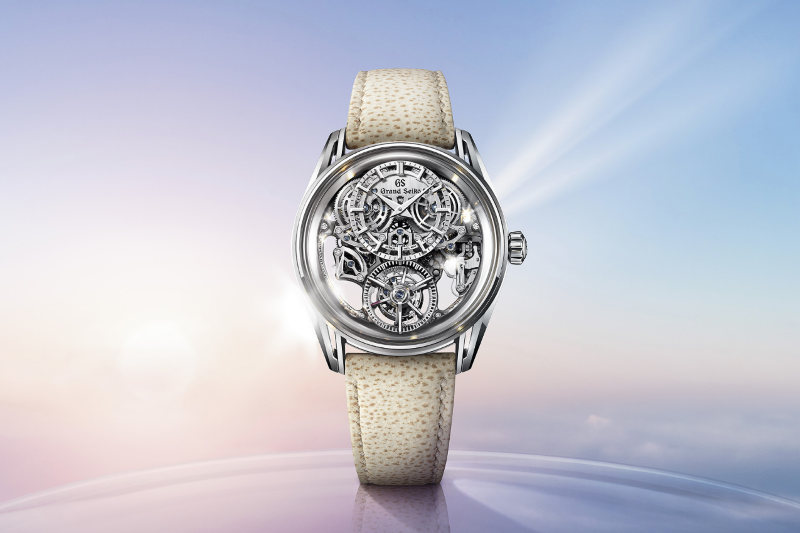
The Swiss, still carrying scars of the quartz crisis, which they claimed Japanese companies were responsible for, have also been sitting up. Naito believes Grand Seiko, awarded the Chronometry Prize at the 2022 Grand Prix d’Horlogerie de Genève (GPHG) for its Kodo Constant-force Tourbillon which shows a complete portrayal of light and shadow, has earned a rightful seat among esteemed watchmaking greats. The Kodo also got a second act this year: a brighter version inspired by daybreak that complements the first.
“We submitted the Kodo under the tourbillon category at the GPHG, but when our name wasn’t called, we were very disappointed,” recalls Naito. I remember comforting (movement designer) Takuma Kawauchiya. However, little did we know that we won the Chronometry Prize instead, which rewards the best competing timepiece for its high-precision timekeeping performance. That recognition meant a lot to us, as pursuing accuracy has been at the core of our craft since day one.
“In the new Kodo, the open-work design not only reveals the beauty of hand-finished movement but also expresses how open spaces have been considered to reflect an important Japanese aesthetic that respects the use of empty space. At the end of the day, we want to present to our customers not just a precise mechanism but a functional tool that carries sentimental value.”
Grand Seiko has trained up a new generation of artisans to carry out that vision. “We’ve always emphasised the spirit of takumi, the way our watchmakers pour their hearts and entire selves in every detail of the process. Finding the right talent who have the potential to become good watchmakers is very important. They are, after all, pillars of the brand.”
Franziska Gsell
Chief marketing officer, IWC Schaffhausen
iwc_franziskagsell_1.jpg

In the late 1930s, two merchants from Portugal requested from IWC Schaffhausen a marine precision instrument for the wrist. The result was a watch with an imposing size, simple Arabic numerals, slim feuille hands and a railway-track-style chapter ring. The clean dial and crisp design laid the foundation for the Portugieser collection, which aged like fine wine, evolving into a timeless, modern icon.
This year’s novelties revolve around the theme “A Tribute to Eternity” and, to CMO Franziska Gsell, that means celebrating “the essence of timelessness”. A range of new colours inspired by the perpetual cycle of day and night dresses a series of revised Portugieser pieces in Horizon Blue, Dune, Obsidian and Silver Moon, but the compelling Eternal Calendar, the collection’s highlight, effectively captures the transient, yet enduring, nature of time through the company’s first secular calendar.
This feat of engineering allows the watch to account for the three leap-year exceptions for the next 400 years as per the Gregorian calendar. “For me, it is ingenious simplicity because it takes a wheel with only eight parts to make that happen. For the moon phase, we have an accuracy of 45 million years. We’ve done the calculations and made models out of it. The previous record was only two million and we’re in the midst of applying for a Guinness World Record.”
iwc-iw5057012.jpg
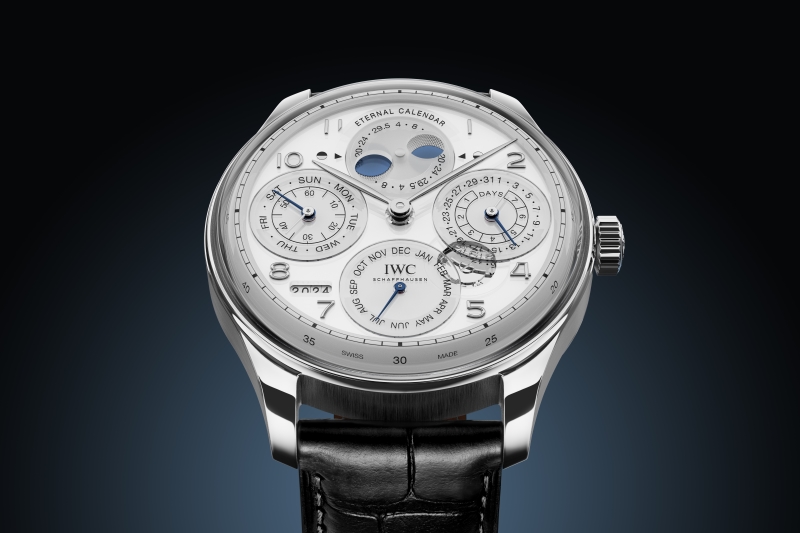
Gsell sees herself and the team as storytellers. To craft the tale of eternity, she enlisted the help of legendary composer and Friend of the Brand Hans Zimmer to encapsulate the atmosphere and moods of a passing day in a score to be played at the IWC booth at Watches and Wonders Geneva.
“It’s a funny story. When we briefed Hans, I said I’d like to have a piece of music that sounds like time. ‘That’s easy!’ he said, while jokingly reenacting Beethoven’s 5th Symphony.” While Zimmer was working on the compositions, he and renowned physicist and friend Prof Brian Cox were brought together for a meeting of minds. The unlikely pair exchanged thoughts on the Eternal Calendar and discussed the inextricable relationship between art and science. The unique perspectives shared by Cox as a scientist inspired Zimmer while he composed the grandiose score, which is played once every hour at the booth to emphasise time’s fleeting nature.
Those who would like to hear it performed live can look forward to Cox’s Symphonic Horizons show at the Royal Opera House, London, in August, where he will present the track with Zimmer for the first time.
Sadry Keiser
Chief marketing officer, Roger Dubuis
sadry_keiser.jpg

At a watch fair suffused with innovations and ingenuity, being coolly offbeat can make one walk taller. Except, Roger Dubuis has loftier ambitions to match it, too. CMO Sadry Keiser, tasked with articulating the brand’s hyper horology of marrying expressive aesthetics and boundary-pushing design at once, explains why the watchmaker remains the “troublemaker” of the Richemont group.
Keiser says, “Our creativity and savoir faire have no limits, but that does not mean we ignore the foundation. Take, for example, the Orbis in Machina (showcased this year). Usually, the flying tourbillon sits in the wings, but we’ve positioned it proudly in the middle. However, it doesn’t have any central hands. So, we had to reinvent mechanical solutions to tell time while keeping the design spirit alive.
“We want to bring surprise to the audience — and not ‘clients’ because I understand how potential buyers may have reservations — every time we put something on the table. To reinterpret haute horlogerie, expressivity through architectural structure needs to change. No rules, our game — that has been our philosophy since day one.”
roger_dubuis_orbis_in_machina_rddbex1119_2.jpg
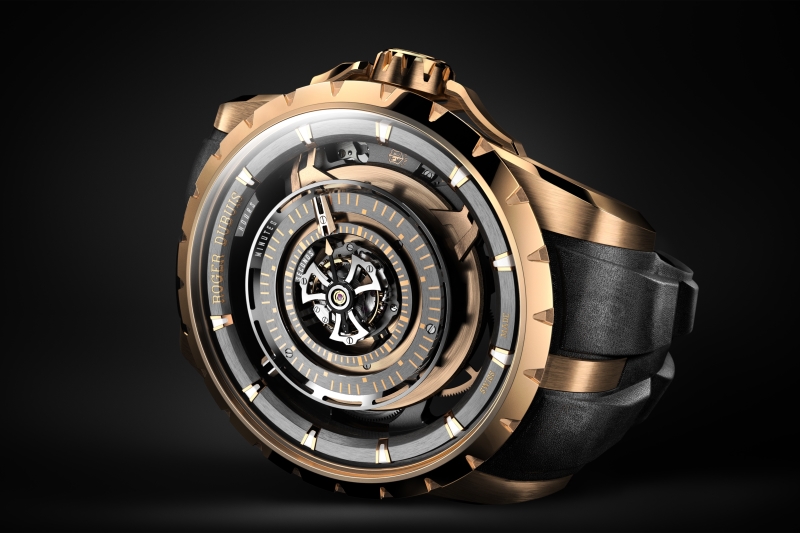
For those who wish to kick-start their Roger Dubuis collection, Keiser recommends the Excalibur Single Flying Tourbillon, a classic that was refreshed with a thinner case with more dramatic clear lines in 2021. Also worth considering is 2024’s line-up: namely, Excalibur Sunrise Double Tourbillon, Excalibur Titanium Monotourbillon and Excalibur Dragon Monotourbillon. Each piece in the maison’s repertoire, led by remarkable complications, skeletonisation and Poinçon de Genève certification, has been a milestone in itself. How many more rules can this wild child break? How hyper can its watches get?
“Innovation has no starting point; so, we can’t really quantify how far we can go. But we’re also attuned to what customers want. Maybe they want a long-lasting material or something ergonomic that is associated with métiers d’art. We will listen. There’s no point introducing a crazy alloy without any additional value. It’s not going to work. What we hope to do is pique the curious with our unique pieces, allow them to get to know our DNA as a serious player in the horological world, and eventually why Roger Dubuis exists.”
Jean-Christophe Babin
CEO, Bvlgari
babin_bulgari1.jpg

To dissect the Octo Finissimo Ultra COSC, which measures at just 1.7mm — about the same thickness as your typical strand of spaghettini — from a technical standpoint is to overlook the philosophical and business acumen that go into creating this record-setter (again, this is the thinnest chronometer watch). Its predecessor was controversial, not just for its contentious-looking QR code linked to an NFT, but also for how quickly its claim of being the slimmest-ever watch was overturned by Richard Mille’s RM UP-01. Bvlgari CEO Jean-Christophe Babin says being beaten was cause for celebration, as it encouraged healthy competition, but did this “damper” also fuel his pursuit to reclaim the title?
“I must stress that we’re not doing it to break another record. It just so happened that we were already working towards a COSC-certified model of the Octo Finissimo Ultra. But we don’t go thin for the sake of going thin; it has to be with some kind of additional feature or complication,” he says.
The other big flex is that Bvlgari has not just crafted the piece from titanium, but the artisans have also made a platinum alternative that is more difficult to deal with because of its density. The Octo portfolio is not just a vast ground for play but also an ongoing canvas for testing out unprecedented challenges.
octo_finissimo_ultra_cosc.jpg
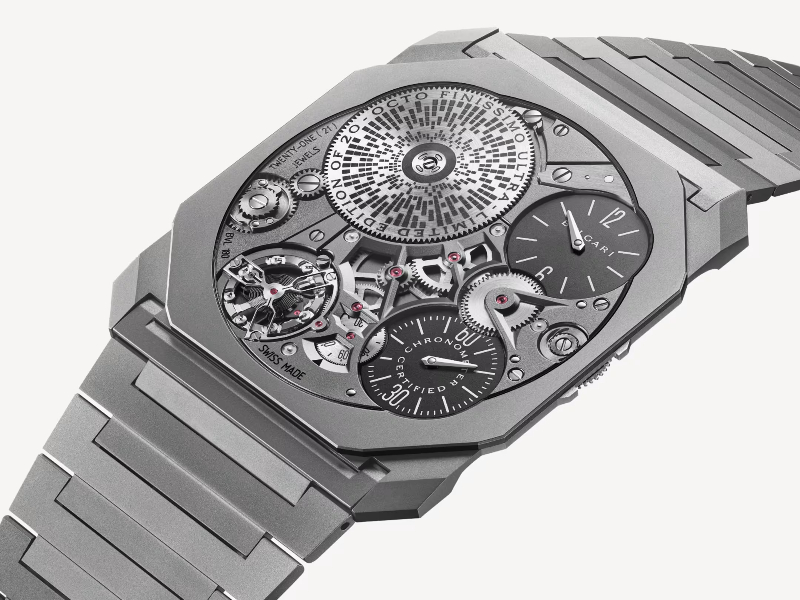
The Italian jeweller’s head honcho elaborates. “We have seven patents as well as two innovations on this one. First, imagine all the kinds of strict processes we did to ensure its accuracy. Next, it comes with a box that will automatically set the time and keep it wound, so the watch is ready when you pick it up. And that QR code some people aren’t happy about? We’ve put a smaller version on the caseback, through which you can access the data metrics. And that’s probably a first in the industry.”
In celebration of Serpenti’s 75th anniversary, the Roman maison has also called upon its friend and famed Japanese architect Tadao Ando to imagine a new collection. Their third collaboration yielded mosaic and mother-of-pearl dials that reflect the fleeting splendour of nature through the seasons: green aventurine (summer); tiger’s eye orange (autumn); icy blue (winter); and sakura pink (spring).
“Aligning the Serpenti with the seasons feels almost instinctive, especially when time represents the end of a cycle and the promise of renewal. Likewise, the serpent sheds its skin and emerges anew; its colours transform. We’ve always loved the work of Tadao, and what great opportunity this was to restore the relationship of architecture and nature through this partnership,” says Babin.
Working with colourful gemstones has expanded Bvlgari’s reservoir of ideas. But is there a challenge the house wishes to attempt?
“Our forte has always been jewellery and ladies’ watches. I know there are a lot of those in the market, but are you really designing ladies’ watches or watches with reduced sizes? Discerning customers want to invest in true craftsmanship, something they can hold and see. We’ll be focusing our efforts on our micro mechanical expertise for women and, for men, we’ll still showcase the same engineering [prowess] but not utilise materials that immediately yell ‘expensive’.”
Bruno Belamich
Co-founder and creative director, Bell & Ross
bruno-belamich-01.jpg

Black is back for Bell & Ross, and what better way to execute the inky shade than with a material that amalgamates with it. Impervious to scratches, light and ultra-resistant, ceramic has been a key matter for watchmaking, but it is the first time the Franco-Swiss brand is using the technical material in its urban line, to adorn three new BR 05 models.
Technical ceramic has always been an integral part of the aeronautics and space industries, and is used mainly for manufacturing rocket nose cones and heat shields for spacecrafts. Bell & Ross’ whole schtick originates from reinterpreting aircraft instrument panels onto timepieces. So, the recurrent question that co-founder and creative director Bruno Belamich heard all day at the annual fair was: Why now?
“Maybe we should have started this collection with ceramic. We did so with stainless steel because we thought it was the best way for our customer to understand what this watch is for,”
Belamich explains. The BR 05 was launched as a more versatile option — compared to the BR 01 and BR 03, which are timepieces straight out of a dashboard — that seeks to open up its aviation heritage to a wider audience.
p13-011-br05-black-ceramic-rubber-0333-2.jpg
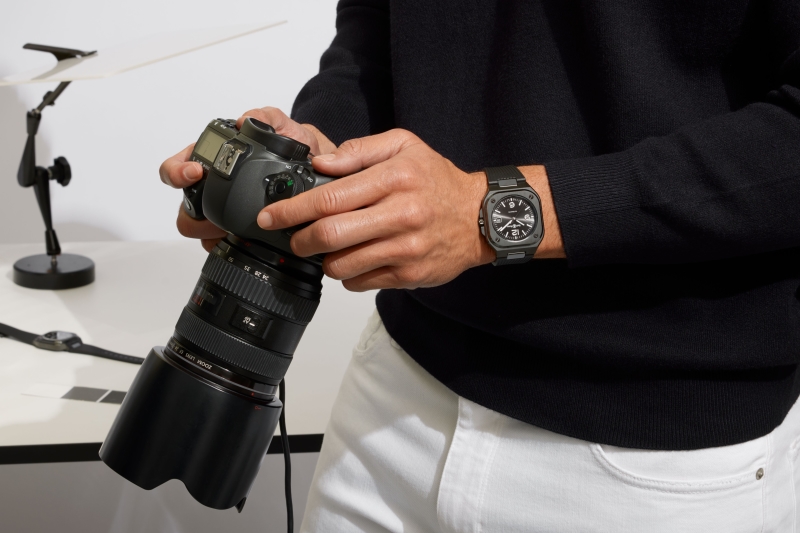
“We thought it was essential to introduce it in black, our colour, by using this high-tech ceramic material, which is the best for black watches. It is scratch-resistant, lighter and also very comfortable,” Belamich says.
When designing a timepiece, there are key considerations that he often sticks to. “My design principles are readability, reliability, water resistance and so on. If it’s not functional, it needs to be comfortable.
“We all know nobody now actually buys a chronograph for the function. Most people who buy chronographs are in for the high-tech functional look of the watch. In the 1960s, watch designers responded to the usefulness of the product, but now they create accessories. Of course, aesthetics were also important in the 1950s and 1960s, but now it is 100% an aesthetic and status choice.”
Reconciling functionality and visual appeal is Belamich’s job, but the new designs are also devised to evolve the company’s existing line of products. These modern timepieces fully take on their status as instrument watches that doff their hat to aeronautic connoisseurs and contemporary aficionados alike.
This article first appeared on July 22, 2024 in The Edge Malaysia's horological special 'Calibre'.


